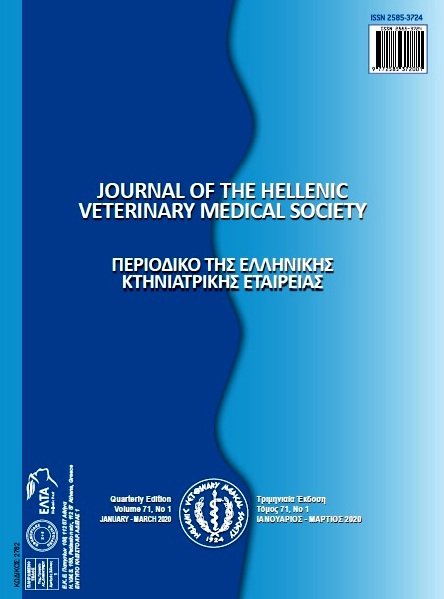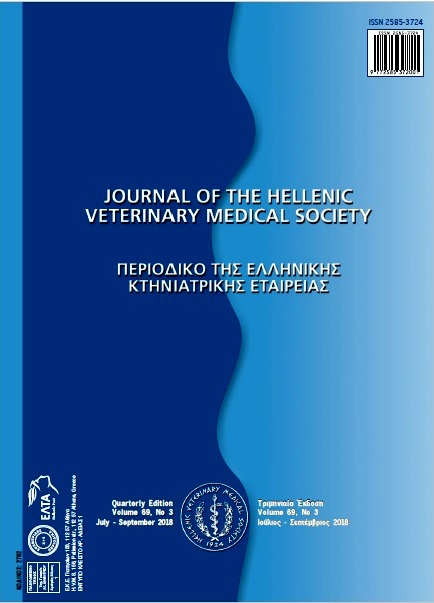Clinical signs, aetiology and outcome in 30 cats with recurrent seizures (2002-2018)
Abstract
The purpose of the current study was to describe seizure types, aetiology, treatment response and outcome in 30cats with recurrent seizures. This retrospective case series study included the medical records of client-owned cats, admitted to the Clinic of Companion Animals for seizure disorders, from 2002 to 2018. Recorded data included history, seizure type, physical and neurological examination findings, blood pressure measurements, complete blood counts, serum biochemistry profile and urinalysis, tentative/final diagnosis, treatment, hospitalization and longterm outcome. A total of 298 feline neurology cases were examined during the study period. Of those, 38 cases were admitted for seizure disorders and 30 met the inclusion criteria. Median age on admission was 38,2 months (3,1 years) (range 2 months- 14 years old).Seizure types, as per owner description, were generalized (26 cats), focal with secondary generalization (3 cats), focal (2 cats) and complex (1 cat). Cluster seizures appeared at least once in 18/30 and status epilepticus in 7/30. Different seizure types were also recorded in individual cases. Fifteen cats (15/30) were hospitalized at least once and the duration of hospitalization ranged from 1-10 days. In most cases, in which diagnosis was established, epilepsy wassecondary (25/30), due to previous head trauma(11/30),metabolic (1/30), or inflammatory (4/30) disease, arterial hypertension (3/30), toxicosis (3/30) and intracranial neoplasia (2/30).Congenital hydrocephalus was detected in 1 cat. Tentative diagnosis could not be established in 5cats; however differential diagnosis included inflammatory or neoplastic encephalopathies.Antiepileptic drug monotherapy (phenobarbital or levetiracetam) was sufficient to control the seizures in 14 cases, while administration of combination therapy with 2 or more antiepileptic drugs was required in 5 cases (phenobarbital, levetiracetam, gabapentin). Successful control was achieved in 11/30 animals for 1-5 years. Seven cats required intensive care at least once due to status epilepticus. Until today, eighteen (18/30) cats are still alive and 11 died or were euthanized.Although in most cases epilepsy was secondary, seizure control was adequate and quality of life (QoL) was improved with antiepileptic drugs when metabolic, inflammatory and neoplastic encephalopathies were excluded.
Article Details
- Zitationsvorschlag
-
KALOGIANNI, L., BAKA, R. D., & POLIZOPOULOU, Z. S. (2020). Clinical signs, aetiology and outcome in 30 cats with recurrent seizures (2002-2018). Journal of the Hellenic Veterinary Medical Society, 71(1), 1985–1990. https://doi.org/10.12681/jhvms.22940
- Ausgabe
- Bd. 71 Nr. 1 (2020)
- Rubrik
- Research Articles

Dieses Werk steht unter der Lizenz Creative Commons Namensnennung - Nicht-kommerziell 4.0 International.
Authors who publish with this journal agree to the following terms:
· Authors retain copyright and grant the journal right of first publication with the work simultaneously licensed under a Creative Commons Attribution Non-Commercial License that allows others to share the work with an acknowledgement of the work's authorship and initial publication in this journal.
· Authors are able to enter into separate, additional contractual arrangements for the non-exclusive distribution of the journal's published version of the work (e.g. post it to an institutional repository or publish it in a book), with an acknowledgement of its initial publication in this journal.
· Authors are permitted and encouraged to post their work online (preferably in institutional repositories or on their website) prior to and during the submission process, as it can lead to productive exchanges, as well as earlier and greater citation of published work.




